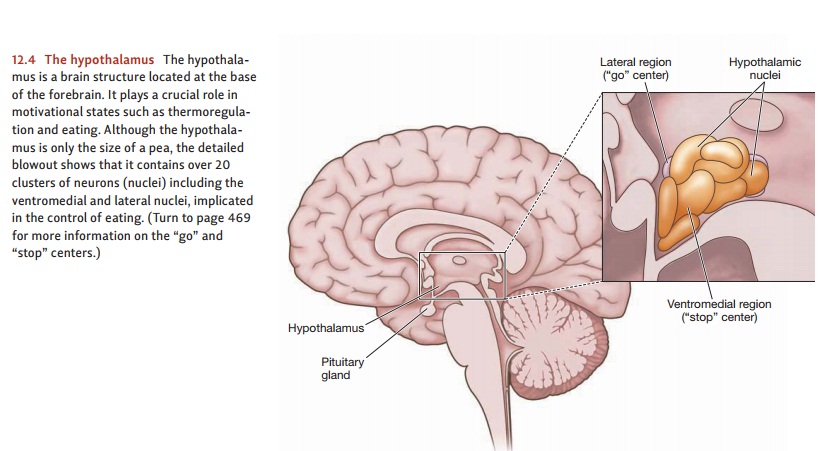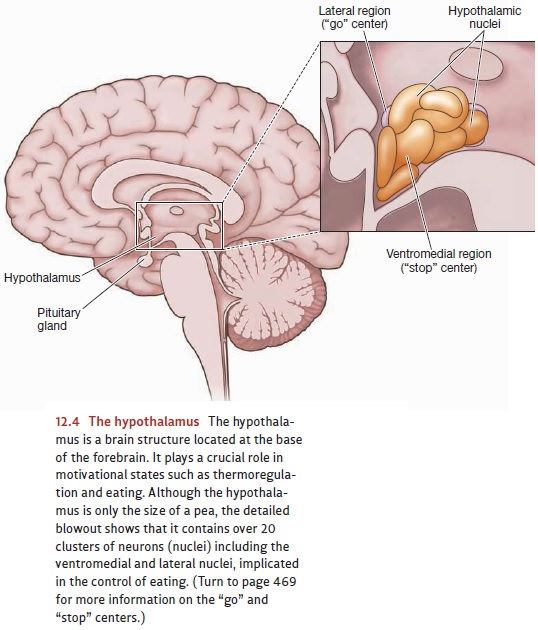Chapter: Psychology: Motivation and Emotion
Thermoregulation

THERMO REGULATION
One
of our basic biological motivations centers on thermoregulation, which refers to maintaining our body temperature
so that we are neither too cold nor too hot. This powerful motive merits
discussion on its own, but, in addition, our exploration of ther-moregulation
will lay the groundwork for considering other, more complex motives.
All
mammals and birds are endotherms,
organisms that maintain stable body temper-atures. (Fish, reptiles, and many
other organisms, in contrast, are ectotherms;
they have a far more variable internal temperature.) Endotherms use many
mechanisms to hold their temperatures more or less constant, including
large-scale bodily changes such as gaining weight and growing fur in
preparation for cold months, and losing both during warm months. They also
change their behavior, such as moving into an insulated nest when the weather
gets cold.
In addition, endotherms rely on a number of more immediate changes to control their temperatures, with these changes directly controlled by the two branches of the autonomic nervous system (ANS), which we discussed. As noted there, the ANS has two parts: the sympathetic branch, which tends to “rev up” bodily activities in preparation for vigorous action, and the parasympathetic branch, which tends to restore the body’s internal activities to normal after the action has been completed. These divisions of the ANS act reciprocally, and so excitation of the sympathetic branch leads to an increased heart rate, while excitation of the parasympathetic branch leads to cardiac slowing. Sympathetic activation slows down peristalsis (rhythmic contractions of the intestines) so that we’re not using energy for digesting when we’re on the run; parasympathetic activation does the opposite—it speeds up peristalsis.
How
does the ANS help control temperature (Figure 12.3)? When the body’s inter-nal
temperature gets too high, this activates the parasympathetic branch of the
nervous system, which triggers a series of changes, including sweating (in
humans) and panting (in dogs), both of which produce heat loss by evaporation,
and vasodilation, a widening of the skin’s capillaries. Vasodilation sends warm
blood to the body’s surface so that heat can be released. As the body cools,
the triggers for these actions are no longer present, so sweating and
vasodilation cease.

The
opposite pattern comes into play when the animal’s internal temperature drops
too low. Here the sympathetic branch acts to conserve heat. Sweating and
panting stop, and vasoconstriction occurs—a contraction of the capillaries that
squeezes blood away from the body’s cold periphery and keeps it instead in the
warmer core.
What
governs the ANS itself ? Said differently, where is the body’s (version of a)
ther-mostat? A crucial brain region is the hypothalamus, located at the base of
the forebrain (Figure 12.4). This brain structure is only about the size of a
pea, but it contains over 20 clusters of neurons that regulate many of the
body’s internal systems. Among its other functions, the hypothalamus appears to
contain a control mechanism that detects when the body is too cold or too hot.
This was shown many years ago in an experiment in which researchers implanted
an electrode in the anterior hypothalamus of cats. When the electrode was
heated gently, the cats panted and vasodilated as though they were too hot and
needed to cool themselves, even though their body temperature was well below
normal (Magoun, Harrison, Brobeck, & Ranson, 1938).

Temperature regulation provides a clear example of homeostatic control, and also illustrates the ways homeostasis is often controlled by anticipation, rather than just immediate cues. Of course, all organisms do respond to current circumstances, and so they sweat (or pant) and vasodilate when they are hot, and move into the shade. They shiver and vasoconstrict when cold, and seek out heat sources or shelter. In addition, many animals respond to temperature changes that haven’t happened yet. Bears start growing their heavy winter coats weeks before the cold arrives. Many animals start building their nests, or digging their winter burrows, well before the seasons change. Desert foxes hunt during the cooler parts of the day so that they’ll be ready to retire into the shade when the temperature rises. In all cases, the behaviors prevent (or diminish) a change in body temperature, rather than coping with the change when it occurs.
Humans
do the same—although in richer and more sophisticated ways. We buy sweaters
before the autumn begins. We pack bathing suits into our suitcase when we are
headed for a warm-weather vacation. We stock up on cold drinks when tomor-row’s
forecast is sunny, and extra firewood when the forecast indicates that snow is
coming. Plainly, therefore, thermoregulation relies on diverse mechanisms—at
least some of which reflect a complexity that is rooted in our learning and
culture.
Related Topics